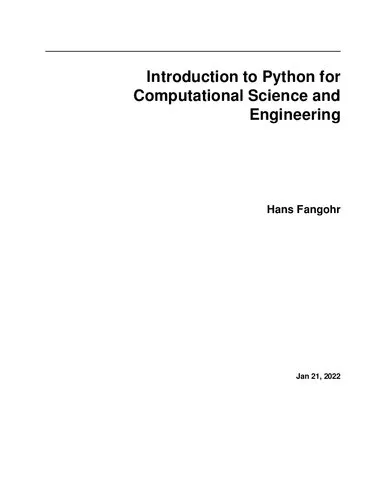An Introduction to Python for Computational Science and Engineering
4.3
بر اساس نظر کاربران

شما میتونید سوالاتتون در باره کتاب رو از هوش مصنوعیش بعد از ورود بپرسید
هر دانلود یا پرسش از هوش مصنوعی 2 امتیاز لازم دارد، برای بدست آوردن امتیاز رایگان، به صفحه ی راهنمای امتیازات سر بزنید و یک سری کار ارزشمند انجام بدینمعرفی کتاب "An Introduction to Python for Computational Science and Engineering"
کتاب "An Introduction to Python for Computational Science and Engineering"، نوشتهی هانس فانگور، یکی از منابع اولیه و مهم برای علاقهمندان به علوم محاسباتی و مهندسی است که زبان برنامهنویسی Python را به طور عمیق و کاربردی آموزش میدهد. این کتاب به طور خاص برای دانشجویان، محققان و علاقهمندان به کاربردهای علمی Python طراحی شده است و اصول پایهای و ابزارهای پیشرفتهی لازم را پوشش میدهد.
خلاصهای جامع از کتاب
این کتاب در چندین فصل طراحی شده است که در هر فصل یک بخش از Python یا کاربردهای محاسباتی آن به صورت سیستماتیک توضیح داده میشود. در فصلهای اولیه، خواننده با اصول اولیه Python آشنا میشود، مانند متغیرها، توابع، حلقهها و شرطها. سپس در فصلهای بعدی موضوعات پیشرفتهتری مانند استفاده از NumPy، Matplotlib و ابزارهای دیگر پردازش داده بررسی میشود.
فصول متأخر کتاب بیشتر به کاربردهای واقعی Python در زمینههای علوم و مهندسی اختصاص دارند. خوانندگان میتوانند یاد بگیرند چطور ابزارهای محاسباتی برای شبیهسازیها، تحلیل دادهها و مدلسازی سیستمهای مهندسی ایجاد کنند. در تمامی طول کتاب، تمرکز اصلی بر روی کاهش پیچیدگی مفاهیم و نمایش کاربردهای عملی به همراه مثالهای واضح و کدهای آموزشی است.
این کتاب علاوه بر ارائهی توضیحات دقیق و جامع، به خوانندگان کمک میکند مهارتهای لازم برای تحلیل و حل مشکلات پیچیدهی علمی و مهندسی با استفاده از Python را کسب کنند.
نکات کلیدی کتاب
- آموزش کامل مبانی Python برای کاربران مبتدی و نیمهپیشرفته.
- تمرکز بر روی ابزارها و کتابخانههای پرکاربرد در علم محاسباتی، مانند NumPy، SciPy و Matplotlib.
- معرفی کاربردها و قابلیتهای واقعی Python در مسائل علمی و مهندسی.
- شامل مثالهای عملی و تمرینهای کاربردی برای تقویت مهارتها.
- ارائهی سبک آموزشی جامع، روان و بر اساس نیازهای واقعی دانشجویان و محققان.
نقل قولهای مشهور از کتاب
"Understanding the fundamental aspects of Python and computational tools is the first step to solving some of the world's most complex scientific problems."
"This book is written with the idea of simplicity and practicality in mind, making Python accessible to everyone in the scientific community."
چرا این کتاب اهمیت دارد؟
در دنیای امروز که علوم محاسباتی و تحلیلی پایهی بسیاری از پژوهشها و صنایع هستند، آشنایی عمیق با ابزارهای برنامهنویسی مانند Python نقشی کلیدی در موفقیت افراد دارد. این کتاب یکی از معدود منابعی است که به طور جامع و مختص نیازهای دانشجویان و محققان در علوم و مهندسی طراحی شده است.
Python به دلیل سادگی، گستردگی کتابخانهها و قابلیت اجرای سریع الگوریتمهای پیچیده، به ابزار اصلی پژوهشگران و مهندسان در سراسر دنیا تبدیل شده است. این کتاب علاوه بر ارائهی آموزشهای فنی، با زبانی ساده و قابل فهم نوشته شده است که آن را برای مخاطبان گستردهای مناسب میسازد.
با مطالعهی این کتاب، خوانندگان نه تنها میتوانند پروژههای ساده و پیچیدهی محاسباتی را اجرا کنند، بلکه به توانایی تحلیل و مدلسازی مسائل واقعی نیز دست مییابند. این مسأله باعث میشود که این کتاب یکی از منابع ضروری برای هر فردی باشد که علاقهمند به علوم و مهندسی محاسباتی است.
Introduction to "An Introduction to Python for Computational Science and Engineering"
"An Introduction to Python for Computational Science and Engineering" is a comprehensive textbook designed to bridge the world of programming and scientific computation. Written by Hans Fangohr, this book provides an accessible and practical guide for students, researchers, and professionals who aim to utilize Python as a tool for solving complex scientific and engineering problems. The book focuses on equipping readers with the essential programming skills they need alongside a deep understanding of computational methods, enabling them to apply these concepts effectively in their respective disciplines.
Detailed Summary of the Book
Programming has become an indispensable skill in modern-day science and engineering, and Python has emerged as one of the most popular programming languages in these domains. This book begins by introducing Python from scratch, making it accessible even to complete programming novices. Gradually, it builds upon that foundation to cover essential topics such as control flow, object-oriented programming, and numerical computation. The author places special emphasis on clarity and practical applications, using examples that are grounded in real-world scientific and engineering contexts.
The book isn’t purely about learning Python; instead, it connects programming to the art of computational thinking. Readers are introduced to fundamental numerical methods, including solving differential equations, numerical integration, matrix operations, and data visualization. Alongside, practical examples and exercises demonstrate how Python can be leveraged to implement these techniques efficiently.
With numerous exercises, carefully crafted examples, and practical code snippets, the book also highlights how Python libraries such as NumPy, SciPy, and Matplotlib can significantly amplify the computational power of scientists and engineers. As a hands-on guide, it encourages readers to actively try out code examples and adapt them to their own applications. The step-by-step approach ensures that absorption of programming concepts happens naturally alongside the mastering of computational methods.
Key Takeaways
- Learn Python basics and intermediate programming concepts tailored for computational scientists and engineers.
- Understand the principles of mathematical modeling and algorithm implementation using Python.
- Acquire hands-on experience with Python libraries such as NumPy, SciPy, and Matplotlib to visualize and solve numerical problems.
- Avoid common pitfalls in programming and achieve robust computational workflows.
- Develop practical problem-solving skills through exercises and detailed real-world examples relevant to science and engineering.
Famous Quotes from the Book
"Computational science is not about producing perfect results; it is about understanding the limitations of approximations and the judicious application of computational tools."
"Python empowers scientists and engineers to focus on their problems, rather than getting bogged down in implementation details."
Why This Book Matters
In a world increasingly dominated by data and computation, the ability to program effectively is no longer a luxury but a necessity. This book provides the foundation and skills required to harness the computational power of Python, enabling users to solve real-world problems across scientific and engineering domains. It demystifies programming, making it accessible and enjoyable for students and professionals who may have never coded before.
By emphasizing practical applications and presenting clear explanations, Hans Fangohr unlocks the potential for innovation and discovery through computation. This book cultivates confidence and competence in using Python not only as a programming language but as a problem-solving tool. Whether you’re analyzing large datasets, solving differential equations, or visualizing results, this text equips you with the tools to succeed in the computational world.
دانلود رایگان مستقیم
You Can Download this book after Login
دسترسی به کتابها از طریق پلتفرمهای قانونی و کتابخانههای عمومی نه تنها از حقوق نویسندگان و ناشران حمایت میکند، بلکه به پایداری فرهنگ کتابخوانی نیز کمک میرساند. پیش از دانلود، لحظهای به بررسی این گزینهها فکر کنید.
این کتاب رو در پلتفرم های دیگه ببینید
WorldCat به شما کمک میکنه تا کتاب ها رو در کتابخانه های سراسر دنیا پیدا کنید
امتیازها، نظرات تخصصی و صحبت ها درباره کتاب را در Goodreads ببینید
کتابهای کمیاب یا دست دوم را در AbeBooks پیدا کنید و بخرید
1111
بازدید4.3
امتیاز50
نظر98%
رضایتنظرات:
4.3
بر اساس 0 نظر کاربران
"کیفیت چاپ عالی بود، خیلی راضیام"


